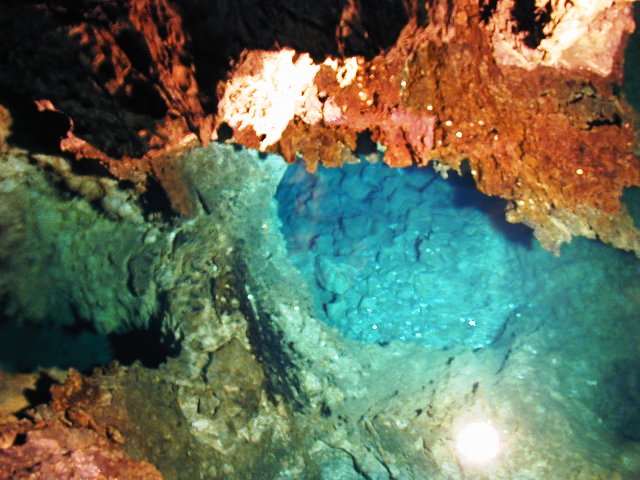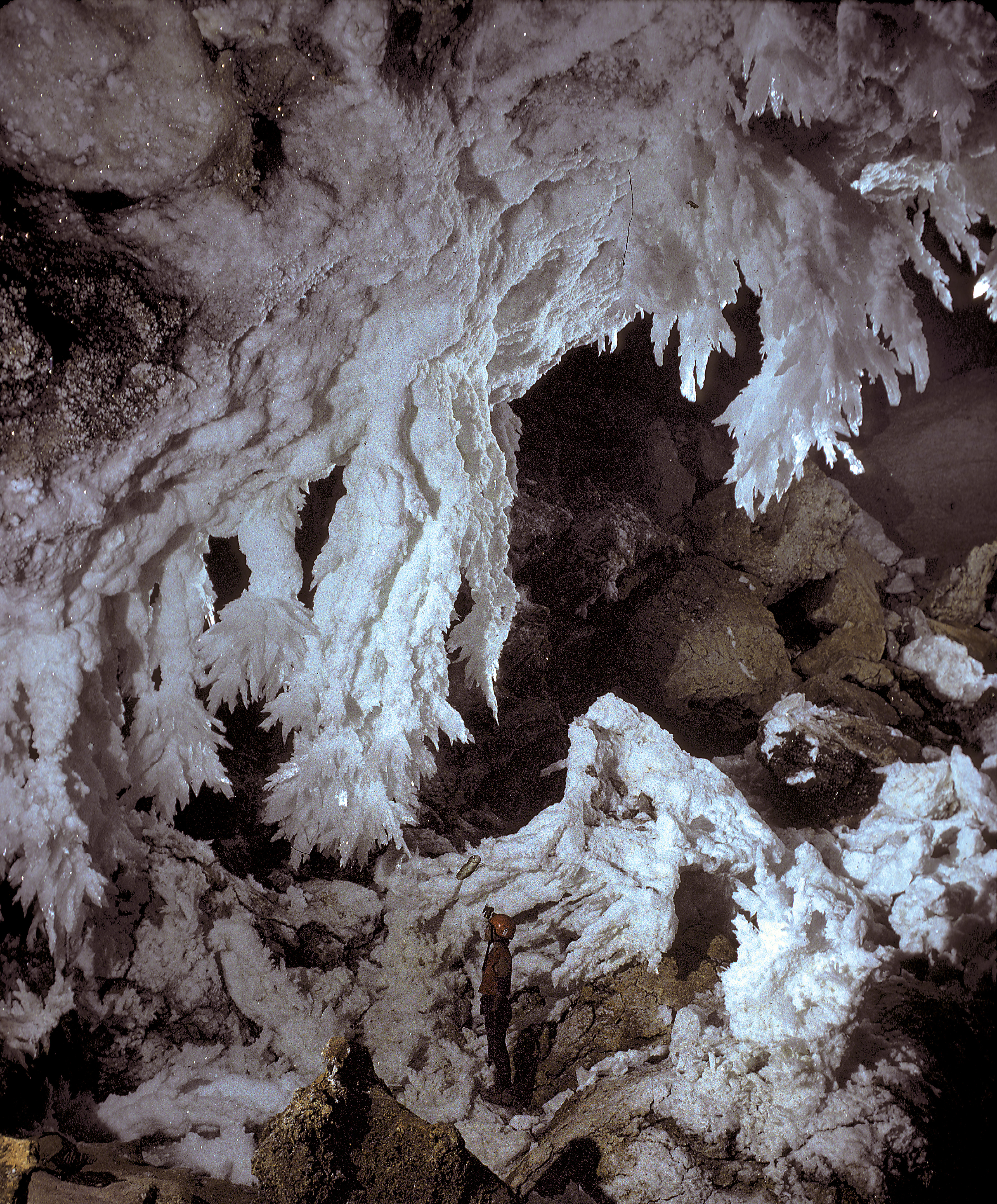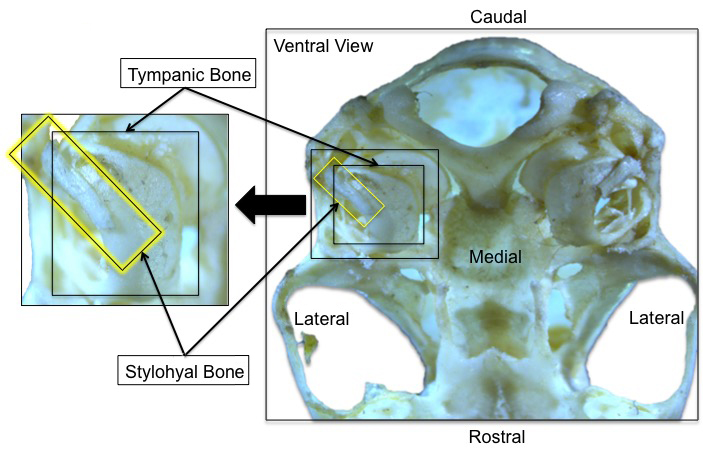|
Ryūsendō
is one of Japan's three largest Solutional cave, limestone caverns. It is located in the town of Iwaizumi, Iwate, Iwaizumi, Iwate Prefecture, in the Tōhoku region of northern Japan. Overview Ryūsendō has an accessible length of 1,200 meters, making it the 62nd longest in Japan; however, its depth of from the entrance to its lowest point is the 5th deepest in Japan. The total confirmed length of the cave is currently , although the cave may extend much further. Further exploration has been banned following a fatality in December 1968. The cave system includes at least four underground lakes, the third of which has a depth of , and the fourth of which (not accessible to the public) has a depth of over . The cave system is also home to colonies of greater horseshoe bat, eastern long-fingered bat, brown long-eared bat and Hilgendorf's tube-nosed bat as well as microbats. Ryūsendō was designated a Natural monument by the Japanese government in 1934. The caves were opened to th ... [...More Info...] [...Related Items...] OR: [Wikipedia] [Google] [Baidu] |
Iwaizumi, Iwate
is a Towns of Japan, town located in Iwate Prefecture, Japan. , the town had a population of 8,006, and a population density of 8.1 persons per km² in 4123 households. The total area of the town is . History The area of present-day Iwaizumi was part of the ancient Mutsu Province, which was dominated by the Nambu clan during the Edo period, who ruled Morioka Domain under the Tokugawa shogunate. With the Meiji period establishment of the modern municipalities system, the village of Iwaizumi was created within Kitahei District on April 1, 1889. Kitahei, Nakahei and Higashihei Districts were all merged into Minamihei District on March 29, 1896. Iwaizumi was elevated to town status on August 1, 1922. On September 30, 1956, Imaizumi annexed the neighboring villages of Akka, Ugei, Okawa and Omoto and on April 1, 1957, annexed the village of Kogawa to reach is present borders. In August 2016, Typhoon Lionrock hit the town with strong winds and heavy rain that caused landslides and f ... [...More Info...] [...Related Items...] OR: [Wikipedia] [Google] [Baidu] |
Iwate Prefecture
is a Prefectures of Japan, prefecture of Japan located in the Tōhoku region of Honshu. It is the second-largest Japanese prefecture (behind Hokkaido) at , with a population of 1,165,886 (as of July 1, 2023). Iwate Prefecture borders Aomori Prefecture to the north, Akita Prefecture to the west, and Miyagi Prefecture to the south. Morioka is the capital and largest city of Iwate Prefecture; other major cities include Ichinoseki, Iwate, Ichinoseki, Ōshū, Iwate, Ōshū, and Hanamaki, Iwate, Hanamaki. Located on Japan's Pacific Ocean coast, Iwate Prefecture features the easternmost point of Honshu at Cape Todo, and shares the highest peaks of the Ōu Mountains—the longest mountain range in Japan—at the border with Akita Prefecture. Iwate Prefecture is home to famous attractions such as Morioka Castle, the Buddhist temples of Hiraizumi, Iwate, Hiraizumi including Chūson-ji and Mōtsū-ji, the Fujiwara no Sato movie lot and theme park in Ōshū, and the Tenshochi park in Kitaka ... [...More Info...] [...Related Items...] OR: [Wikipedia] [Google] [Baidu] |
Japan
Japan is an island country in East Asia. Located in the Pacific Ocean off the northeast coast of the Asia, Asian mainland, it is bordered on the west by the Sea of Japan and extends from the Sea of Okhotsk in the north to the East China Sea in the south. The Japanese archipelago consists of four major islands—Hokkaido, Honshu, Shikoku, and Kyushu—and List of islands of Japan, thousands of smaller islands, covering . Japan has a population of over 123 million as of 2025, making it the List of countries and dependencies by population, eleventh-most populous country. The capital of Japan and List of cities in Japan, its largest city is Tokyo; the Greater Tokyo Area is the List of largest cities, largest metropolitan area in the world, with more than 37 million inhabitants as of 2024. Japan is divided into 47 Prefectures of Japan, administrative prefectures and List of regions of Japan, eight traditional regions. About three-quarters of Geography of Japan, the countr ... [...More Info...] [...Related Items...] OR: [Wikipedia] [Google] [Baidu] |
Solutional Cave
A solutional cave, solution cave, or karst cave is a cave usually formed in a soluble rock like limestone (Calcium carbonate, with chemical formula ''CaCO3''). It is the most frequently occurring type of cave. It can also form in other rocks, including chalk, Dolomite (rock), dolomite, marble, Evaporite, salt beds, and gypsum. Process Bedrock is dissolved by carbonic acid in rainwater, groundwater, or Humic substance, humic acids from decaying vegetation, that seeps through Bed (geology), bedding planes, Geological fault, faults, Joint (geology), joints, and the like. Over time, the surface terrain breaks up into Limestone pavement, clints separated by grikes and punctuated by Sinkhole, sinkholes into which streams may disappear, crevices expand as the walls are dissolved to become caves or cave system. These may turn into large caverns or ''dolines'' when the roof collapses. The portions of a solutional cave that are below the water table or the local level of the groundwater a ... [...More Info...] [...Related Items...] OR: [Wikipedia] [Google] [Baidu] |
Tōhoku Region
The , Northeast region, , or consists of the northeastern portion of Honshu, the largest island of Japan. This traditional region consists of six prefectures (): Akita, Aomori, Fukushima, Iwate, Miyagi, and Yamagata. Tōhoku retains a reputation as a remote, scenic region with a harsh climate. In the 20th century, tourism became a major industry in the Tōhoku region. History Ancient and classical period In mythological times, the area was known as Azuma (, ) and corresponded to the area of Honshu occupied by the native Emishi and Ainu. The area was historically the Dewa and the Michinoku regions, a term first recorded in (654). There is some variation in modern usage of the term "Michinoku". Tōhoku's initial historical settlement occurred between the seventh and ninth centuries, well after Japanese civilization and culture had become firmly established in central and southwestern Japan. The last stronghold of the indigenous Emishi on Honshu and the site of ... [...More Info...] [...Related Items...] OR: [Wikipedia] [Google] [Baidu] |
Underground Lake
An underground lake or subterranean lake is a lake underneath the surface of the Earth. Most naturally occurring underground lakes are found in areas of karst topography, where limestone or other soluble rock has been weathered away, leaving a cave where water can flow and accumulate. Natural underground lakes are an uncommon hydrogeological feature. More often, groundwater gathers in formations such as aquifers or springs. The largest underground lake in the world is in Dragon's Breath Cave in Namibia, with an area of almost ; the second largest is The Lost Sea, located inside Craighead Caverns in Tennessee, United States, with an area of Characteristics An underground lake is any body of water that is similar in size to a surface lake and exists mostly or entirely underground; though, a precise scientific definition of what may be considered a "lake" is not yet well-established. underground lakes could be classified as either "lakes" or "ponds", depending on charac ... [...More Info...] [...Related Items...] OR: [Wikipedia] [Google] [Baidu] |
Greater Horseshoe Bat
The greater horseshoe bat (''Rhinolophus ferrumequinum'') is an Insectivore, insectivorous bat of the genus ''Rhinolophus''. Its distribution covers Europe, Northern Africa, Central Asia and Eastern Asia. It is the largest of the horseshoe bats in Europe and is thus easily distinguished from other species. The species is sedentary, typically travelling up to between the winter and summer roosts, with the longest recorded movement being . The frequencies used by this bat species for echolocation lie between 69–83 kHz, have most energy at 81 kHz and have an average duration of 37.4 ms. Description The greater horseshoe bat is the largest horseshoe bat in Europe.Schober, W., E. Grimmberger. 1997. It has a distinctive noseleaf, which has a pointed upper part and a horseshoe-shaped lower part. Its horseshoe noseleaf helps to focus the ultrasound it uses to 'see'. The greater horseshoe bat also has tooth and bone structures that are distinct from that of other rhi ... [...More Info...] [...Related Items...] OR: [Wikipedia] [Google] [Baidu] |
Eastern Long-fingered Bat
The eastern long-fingered bat, or big-footed myotis (''Myotis macrodactylus'') is a species of vesper bat found in China, Japan, North Korea, South Korea, and Russia. Roosting in caves and rock crevices during the day, it forages at night for insects near rivers and streams. Taxonomy The eastern long-fingered bat was described as a new species in 1840 by Dutch zoologist Coenraad Jacob Temminck. Temminck placed it in the genus ''Vespertilio'', with a scientific name of ''Vespertilio macrodactylus''. The holotype had been collected in Japan. Some authors previously considered it a subspecies of the long-fingered bat (''Myotis capaccinii''), though it is now widely recognized as a full species. It has three subspecies: *''M. m. continentalis'' Tiunov, 1997 *''M. m. insularis'' Tiunov, 1997 *''M. m. macrodactylus'' (Temminck, 1840) Biology and ecology The eastern long-fingered bat is a social species, with males and females roosting together in colonies that can number several hund ... [...More Info...] [...Related Items...] OR: [Wikipedia] [Google] [Baidu] |
Brown Long-eared Bat
The brown long-eared bat or common long-eared bat (''Plecotus auritus'') is a small Eurasian insectivorous bat. It has distinctive ears, long and with a distinctive fold. It is extremely similar to the much rarer grey long-eared bat which was only validated as a distinct species in the 1960s. An adult brown long-eared bat has a body length of 4.5–4.8 cm, a tail of 4.1–4.6 cm, and a forearm length of 4–4.2 cm. The ears are 3.3–3.9 cm in length, and readily distinguish the long-eared bats from most other bat species. They are relatively slow flyers compared to other bat species. Habitat The brown long-eared bat is found throughout Europe, with the exception of Greece, southern Italy and southern Spain. It is found to the east up to the Urals and Caucasus. The UK distribution can be found on the National Biodiversity Network website and can be seehere Brown long-eared bats regularly utilise buildings roosting in undisturbed roof spaces either singl ... [...More Info...] [...Related Items...] OR: [Wikipedia] [Google] [Baidu] |
Hilgendorf's Tube-nosed Bat
Hilgendorf's tube-nosed bat (''Murina hilgendorfi'') is a species of vesper bat in the family Vespertilionidae. In Japan they are called 'tengu komori', after the mythical creature called the Tengu. It was formerly thought to be a subspecies of ''Murina leucogaster'' (called ''Murina leucogaster hilgendorfi''), but is now known to be a distinct species. Distribution Hilgendorf's tube-nosed bat is found in China, Russia (Primorsky Krai, Primorye and Sakhalin), Kazakhstan, Mongolia, Korea and Japan (Hokkaido, Honshu, Shikoku, and Kyushu). Description Slender faced with tubular nostrils, it has oval ears with a prominent Tragus (ear), tragus, more than half of the ear in height. Fur is soft and curly dark grey with long, silvery guard hairs. It flies relatively low over the ground and hovers. Habitat, diet, hunting They live in forests, mines, caves and tunnels, and occasionally in buildings. Normally, they live alone or a few together, rather than in large colonies. They are ins ... [...More Info...] [...Related Items...] OR: [Wikipedia] [Google] [Baidu] |
Microbat
Microbats constitute the suborder Microchiroptera within the order Chiroptera (bats). Bats have long been differentiated into Megachiroptera (megabats) and Microchiroptera, based on their size, the use of echolocation by the Microchiroptera and other features; molecular evidence suggests a somewhat different subdivision, as the microbats have been shown to be a paraphyletic group. Characteristics Microbats are long. Most microbats feed on insects, but some of the larger species hunt birds, lizards, frogs, smaller bats or even fish. Only three species of microbat feed on the blood of large mammals or birds ("vampire bats"); these bats live in South and Central America. Although most "Leaf-nose" microbats are fruit and nectar-eating, the name “leaf-nosed” isn't a designation meant to indicate the preferred diet among said variety. Three species follow the bloom of columnar cacti in northwest Mexico and the Southwest United States northward in the northern spring and then th ... [...More Info...] [...Related Items...] OR: [Wikipedia] [Google] [Baidu] |






